by Fumitaka Nagamura [President, N.F. Farrd Systems Corp. ]
Initiated by T.A. Edison in 1877 in his cylindrical records with vertically cut sound grooves, and then developed by E.B. Berliner to disc records with laterally cut sound grooves, recorded discs have continued to prosper on a truly firm basis.
Furthermore, though changed little in appearance, improved materials have contributed to the tremendously advanced record cutting technology of today which, after a long period of monaural cutting, developed the binaural (dual groove) and V/L systems, and since 1957 has standardized the 45/45 system stereo discs. In this historical process of changes and selections, it is felt that the direction of future developments has been indicated, though unrecognized.
Against such a background, recorded discs, though at one time appearing to have achieved the ultimate in development, were required to be advanced again when four-channel sound reproduction became the object of such inventors as D. Hafler, P. Scheiber in 1969, and B.B. Bauer in 1970, who developed purely electronic approaches in the form of matrices. On another plane, with the same objective, Inoue and others developed the CD-4 system in 1970 based on innovation in record cutting technique using subcarriers.
It now became obvious that the future direction of recorded discs lay in four or more channel sound reproduction. However, as of this writing, it is felt that the best approach has not necessarily been taken.
Anticipation of New Systems
Considering that recorded discs basically rely on physical and mechanical transducing, a thorough analysis of anticipated future technologies has led to creation of the "QDCS" system to be explained here.
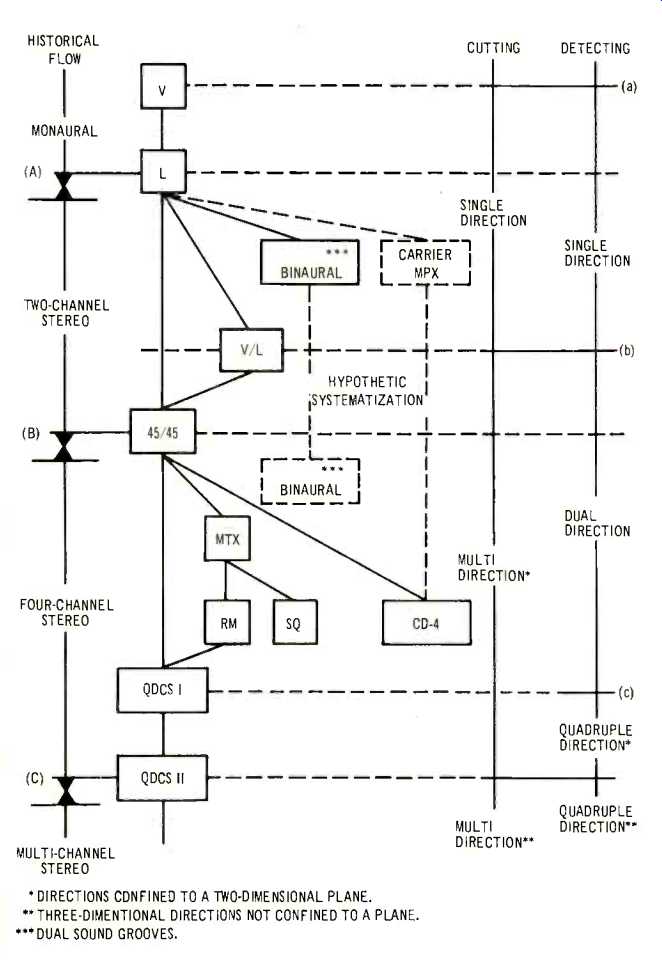
Fig. 1--Perspective of historical progresses of recorded discs.
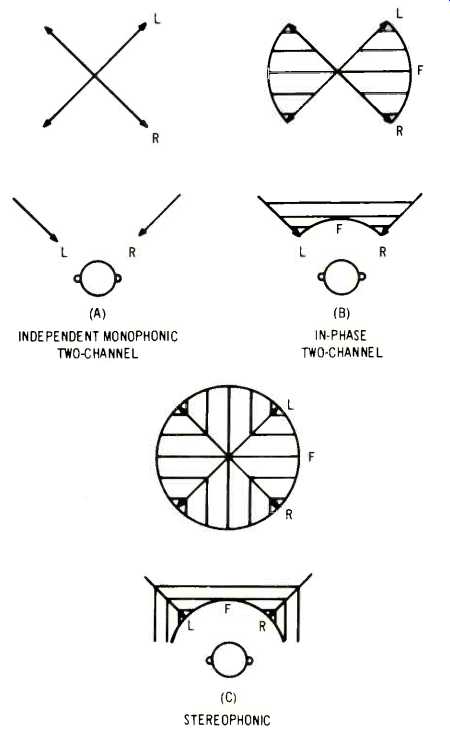
Fig. 2--Sound fields reproduced by 45/45 disc records.
First assigning specific nomenclatures to disc systems that appeared in the history of multi-channelization as well as those that are contemporary, and then reclassifying them according to their sound-groove cutting and detecting channels of direction defined as the number of spatial directions of relative vectors, have resulted in Fig. 1.
With discs as recording media, a direct analysis of transducers used in cutting and tracing sound grooves has suggested a totally new possibility.
Figure 1 shows transducer innovations as horizontal lines, (A) indicating the time in history when monaural discs were perfected, and (B) that when 45/45 two-channel stereo discs made their debut. Both these times coincided with initiation of complete standardization and popularization of the two systems.
(b) in Fig. 1 represents a forerunner or an indication of the 45/45 system soon to emerge, and is a proof that 45/45 discs were not developed independently of prior arts. Similarly, line (c) is drawn to coincide with an innovation in transducers for transition to four-channel stereo systems, and the "QDCS" system has newly been developed to fulfill this anticipation.
(c) thus represents an innovation in sound detection, or playback, and another line (C) is drawn below it to coincide with perfection of the new total system which includes innovations in the sound-groove cutting technology, in a manner resembling (A) and (B) in the past.
To summarize, an innovation in transducers has led to creation of the "QDCS" system which, as anticipated, has proven to be an advanced and generalized form of the 45/45 system.
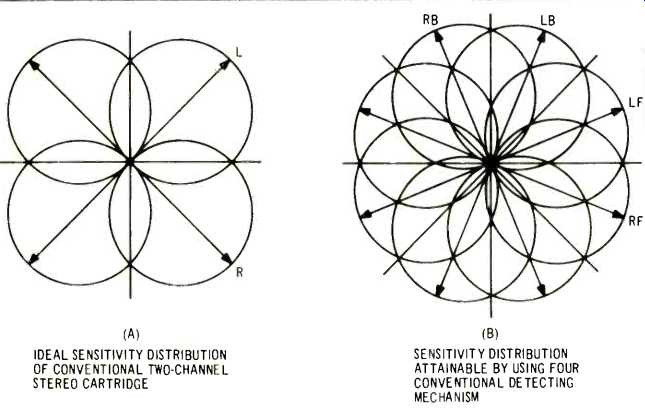
Fig. 3-Directional sensitivity of detection by conventional cartridges.
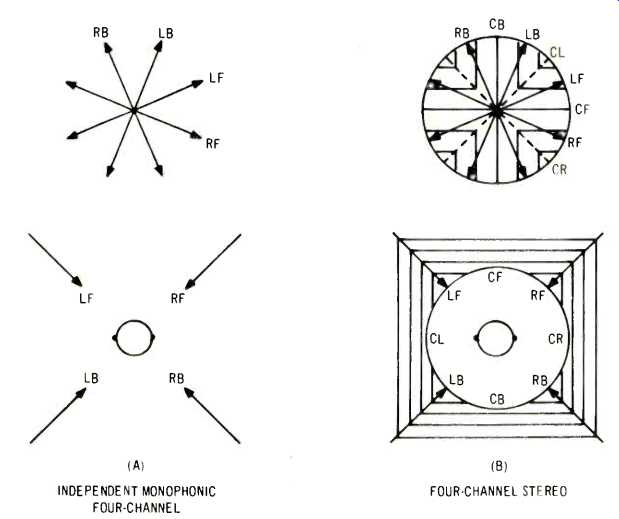
Fig. 4-Sound fields ideally reproduced by four-channel disc records.

Fig. 5--Directional sensitivity of detection by QDCS cartridges.
Disc Cutting and Reproduced Sound Fields
As 45/45 system disc cutters were adopted, mobility of cutter tips encompassed all of the 360 angles around its stationary point of origin. Expression by vectors of these cutter tip motions is convenient, and will be used in the rest of this article.
Relations among sound sources, recorded motional vectors, and reproduced sound fields may be classified into three types, as shown in Fig. 2, for all two-channel recordings.
(A) may be termed monophonic two channel and represents two independently recorded channels that are unrelated to each other. In this case, two independent sound fields are reproduced but these do not intermingle in listening space to produce localized sound image.
(B) with closely related channels which are in phase with each other reproduces a sound field stably localized in the space between the two speakers.
(C) whose channels are further expanded to include out-of-phase relationships can reproduce a sound field that extends beyond the speakers, and a wider special coverage, even though with some inherent ambiguity of sound image localization. Thus with (C), the 360 mobility of cutter tips was at last fully exploited.
The above is based on two-channel playback cartridges whose directional detection sensitivity is distributed as shown in Fig. 3 (A), which means that all motional vectors driving cutting tips are picked up, i.e. detected, without loss, regardless of their direction. A very satisfactory, fully rational system has thus been perfected for two channels.
However, freely selectable angular directions of disc cutting vectors should readily suggest that they need not be confined to two-channel recordings.
Scheiber did succeed in increasing recording channels beyond two, but as he declared no need for improvement of playback cartridges, these were not and still remain unaltered. Perhaps his reasons were that the Fig. 3 (A) sensitivity distribution of conventional cartridges lent itself to his matrix reproduction of four channels, and that furthermore arranging four conventional detection mechanisms along the four channel vector axes merely would have produced a sensitivity distribution like Fig. 3 (B), which represents no improvement whatsoever.
Basically, sound fields reproduced by an ideal system from discs recorded along the foregoing philosophy should be as shown in Fig. 4 (B). However, under contemporary systems, i.e. in matrix reproduction, even when recorded as four monophonic channels as shown in Fig. 4 (A), reproduced sound fields are blended together by crosstalk, and only a 3 dB adjacent channel separation is attainable.
We can conclude from the above analysis that while multichannel sounds can be recorded on a disc independently and without interference with each other, i.e. discretely, only up to two channels can be reproduced discretely as long as contemporary cartridge construction and detecting mechanisms are used. It should also be noted in passing that the Fig. 3 (A) sensitivity distribution is what is necessary and sufficient for two-channel reproduction, and therefore must be maintained unaltered.
Is discrete four-channel reproduction as shown in Fig. 4 (B), then, impossible? No, not if cartridges with sensitivity distribution shown in Fig. 5 (A) are made available. However, as comparison of Fig. 3 (B) and Fig. 5 (A) discloses, it is not possible to build such cartridge using conventional detecting mechanisms. Only by adoption of different vector transmission mechanisms is it feasible to realize a near ideal distribution, such as shown in Fig. 5 (B). "QDCS" cartridges have been developed under the forgoing philosophy, and to maximally enhance their performance, an electronic circuitry entitled "Crosstalk Eliminator" has also been developed. Together they constitute the new reproducing system, "QDCS Mark I". "Matrix" and "Discrete" as Viewed with 45/45 Disc Cutting It might be argued that QDCS is a form of matrix and therefore cannot be termed discrete, but in reality, in the 45/45 disc cutting any localized sound within the 360° angle can be represented by an independent motional vector of the cutter tip, and this one-to-one correspondence is complete and continuous without any discontinuity, fully circularly distributed around the center of the tip motion. In other words, by combination of two independent variables as vector projections on coordinate axes, theoretically an infinite number of channels can be recorded discretely in the sound groove.
Therefore the only portion of this process that may be termed "matrixed" is transmission of signals combined and grouped into 2 channels for feeding to the cutter to drive the record cutting tip, plus playback if two or less channel cartridges are used. Records thus cut are discrete discs in themselves, and if vectors thus independently cut into the sound groove can be directly detected without duplication along three or more spatial directions, it can constitute a discrete reproduction. For instance, if detection and reproduction using a cartridge with Fig. 5(A) sensitivity distribution can be effected along four spatial directions, it may be termed a discrete 4-channel reproduction.
To elaborate further through a comparison with tape recording, each channel in recorded tapes is fundamentally independent and unrelated, so that the number of discrete channels cannot exceed that of recorded tracks, and addition of playback heads does not produce any additional channel.
With recorded discs, on the other hand, two channels of mutually independent signals, Lt and Rt in Fig. 6(A), that are fed into the record cutter with two mechanical motional axes at right angles to each other, get vectorially added to form a single vector T to drive the cutter tip, and are recorded as such with the T spatial direction. In conventional stereo reproduction, this single vector is again decomposed into vector projections, or component vectors, Lt and Rt, and detected as such by a 2-channel cartridge.
The principle of QDCS is to detect the vector T directly either by one element conforming with the spatial direction of T, or two elements aligned along different axes from those designed in for recording input signals. This latter approach is not feasible in tape recording as vector T or its equivalent does not exist, and playback heads in other than predetermined configurations do not afford correct reproduction.
In the case of 4-channel stereo, as shown in Fig. 6(B), signal LF is decomposed into component vectors, Lt and Rt, during 2-channel transmission, but in disc cutting these are recomposed and form the original single vector LF which drives the cutter tip. Conventional 2-channel stereo cartridges detect this vector as two component vectors, Lt and Rt, which are then electrically combined for 4-channel outputs, and thus constitute a matrixed reproduction. QDCS cartridges either detect LF directly by one element, or by two elements whose detection axes do not coincide with LF but lie closest to it.
In the latter case, the elements detect vector projections of LF but these are not electrically combined as in matrixed reproduction, but fed individually to respective speakers. It is the acoustical outputs of these speakers that are spatially combined for proper localization of reproduced sound.
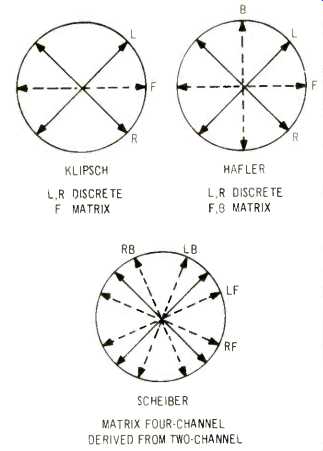
Fig. 8--Examples of conventional multichannel systems represented by vectors.
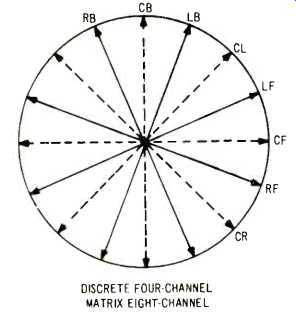
Fig. 9--QDCS multi-channel system.

Fig. 10--Comparison of discs and tapes.
Restriction to two channels applies only to the transmission stages of recording signals, and when these are over, i.e. when disc records are made, the restriction no longer holds. Interaction between more than two channels of information is sometimes inevitable while such information is transmitted via two channels, but disc cutting vectors themselves are independent and do not interact among themselves, as long as the two-channel input signals to recording heads are kept either in phase or in opposite phase. It is detection of these vectors that determines whether it is a matrixed reproduction or discrete.
Axes of input when recording and those of detection in playback do not need to coincide, as seen in the above, and also as has been proven during transition from the V/L to 45/45 system of disc recording. Rather, selection of different sets of axes led to new developments. Classification of monaural and two-channel stereo discs and cartridges, as shown in Fig. 7, should aid this comprehension of compatibility among the various systems.
Taking up the relationship between V/L and 45/45, for instance, signals fed to the V and L axes through additive and substructive matrices are recorded as discrete vectors, L and R, along axes removed 45 in angle. 45/45 picks up L and R vectors directly, an advantage over V/L where both recording and playback must employ add/subtract matrices, which was sufficient for 45/45 to completely replace V/L systems. It should now be evident that similarly QDCS represents full rationalization and simplification of matrix systems.
In Fig. 8, an attempt has been made to illustrate some of the systems employed during transition from two channel to multichannel stereo that may be corroborative to the QDCS principle.
Vectors drawn in straight lines represent those that are directly detected from discs, and others in dotted lines, those that are indirectly detected by means of composite vectors. The former may be termed discrete and the latter matrix.
Klipsch's system was the first matrix, Hafler's a simple matrixial combination of 45/45 and V/L, and Scheiber's a further advanced form based on additional rationalized interpretation in which, however, all the four detecting axes ended up being indirect axes, constituting a pure matrix system.
QDCS, through similar analysis as that described in the foregoing when comparing V/L and 45/45, attained rationalization and simplification by adopting detection axes coinciding with four discrete vectors recorded on the disc. In Fig. 9, these direct detection axes of QDCS are represented in straight lines, and besides five or more channels can be reproduced by incorporating additional indirect detection axes represented by the dotted lines.
Returning to the disc-tape comparison, as shown in Fig. 10, if M number of original sound sources are picked up by X numbers of microphones, in disc recording M' number of independent vectors are recorded on the disc, even though only two channels are employed to transmit the recording signals to the cutter head, so that depending on the recorded program any number (variable X') of channels can be reproduced by using X' pieces of detection mechanisms in the playback cartridge. However, in tape recording, reproduction of more channels than those employed in recording, fixed X', is feasible only through matrices.
The above basic difference constitutes the real value and future potential of discs in the writer's opinion, so that at the expense of discarding compatibility with two-channel tapes as is feasible in the case of matrix systems, four-direction detection has been adopted. Selection of the four, when any number (X') is feasible, has been made for the sake of symmetry and maximum efficiency in crosstalk reduction and other similar considerations.
---------------------
(adapted from Audio magazine, Jan. 1974)
Also see:
Compatible Quadra-Direction Discrete Stereo System Part II (Feb. 1974)
Why You Should Buy Four-Channel Now (Jul. 1973)
The Evolution of Four-Channel Equipment (Jul. 1973)
Status: The CD-4 System (Jul. 1973)
Quadraphonic Headphones (Jun. 1973)
= = = =